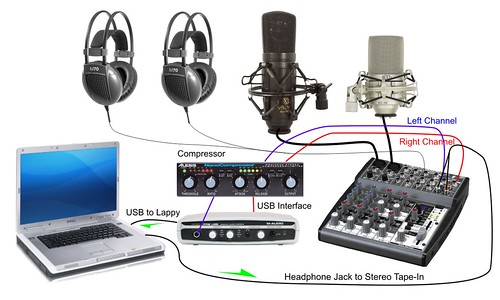Last year I wrote an article about How I Podcast using Skype. I even updated it once. I have some new equipment and my co-host is in the studio (read: basement) with me. I do things a little differently now. This is how someone might do podcasting when both hosts are in the same space.
Hardware
Laptop:
Using an older Dell laptop. Nothing fancy… just has a lot of USB ports.
Mics: MXL V63M Studio Condenser, MXL 990 Condenser
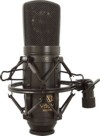
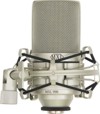
Mixer: Behringer XENYX 1002FX
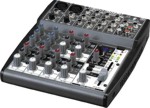
Compressor: Alesis NanoCompressor – Out of Production!

USB Interface: M-Audio MobilePre USB

Headphones: AKG M 70 Headphones
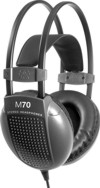
Software
Recording: Audition 1.5 – I know they’ve got a version 3 out… but it’s what I’m used to and I’ve never seen a reason to upgrade. I almost didn’t stop using Cool Edit Pro!
Sound Effect Player: Sound Byte – Sound Byte, put simply, is a way to play sound effects, segment intros, bumpers and voice mails with the lick of a button. It fills you screen (or smaller if you wish) with columns of buttons. You can assign any sound file to any of the buttons.
Software Compressor: CN Levelator – Drag and drop your vocals and watch this simple free software do it’s magic. Until I master the use of my in-line compressor, I always pass my audio through this. It’s not good for music.
ID3 Tag Writer: iTunes – Not only is it needed to publish your podcast, I’ve found that it’s also the perfect ID3 tag writer. I import my final mp3 into iTunes and using the Info window, fill in all of the episode information and even add the artwork. I have iTunes set to manage my music library and have given it permission to change my file names. [source]
The Setup
The diagram below should explain it. Basically you just follow the path of the audio from your face to the recording laptop. Mics plug into the first and second channel on the mixer with XLR cables. The mixer sends a signal to my headphones and another signal to the compressor via two short stereo 1/4 inch instrument cables. The compressed audio leaves the compressor and into the USB interface via two short stereo 1/4 instrument cables. The USB interface pipes the audio into the recording laptop as a stereo signal. The audio from the laptop follows the same path once it gets to the mixer.
The Method
I mix all of my audio in real time. The audio from the laptop and the audio from the mics are all mixed down to one stereo signal which is recorded by the laptop. That means my levels have to be right. I can’t blast out the listener with the music then have the vocals sound low by comparison. I also need to make sure both hosts sound like they’re the same volume.
Mixing in real time is a risk. There is not nearly as much room for error. You can’t go back and raise the volume of one of the hosts if it’s off. You can’t delete a cough on one of the vocal tracks without deleting both. This is an acceptable risk to me. The post-production of a podcast can easily take 3 times as long as the original recording. I have my post-production work down to around 30-45 minutes from end of show to live on the feed.
Since the laptop receives one stereo signal from the USB interface, I simply set Audition to record that signal from the Maudio in the wav form view. Multi-track recoding is possible with my setup (isolating the left and right channels to different tracks with the lappy audio as a third recording from the lappy’s own soundcard) but recoding just the one track means I can use an older machine.
I use my cart program to insert all of the bumpers, intros, voice mails and outtros, in real time, as we record the show. We do pause several times to save the recording.
When we’re done, I add any additional audio (voicemails at the end, sponsor messages to the front) in the multi-track view. This gets mixed down to a new stereo file. I add 7 seconds of silence to the end of the file (because my iPod was chopping off the ends of my shows) and save it once as a wav and once as an mp3.
That mp3 is opened in iTunes. I have iTunes set to copy all audio into it’s own folders and to change the filenames based on the information I enter. I use iTunes to write my id3 tags and add the episode artwork. When I’m done the audio file is renamed and ready to be uploaded.
I use the free FTP program, Filezilla to upload my audio to Libsyn.
I write a new post in WordPress and using the Podpress plugin, add the new audio to my feed. I go back to iTunes to check that my audio is downloading properly. Then I’m done!
Conclusion
I hope this article has helped you understand how I podcast. As I said in my previous article, this is not THE way to podcast… but it’s how I do it.
If you’re planning to start your own show you may find value in one of my other articles in the Podcast Resources category.
